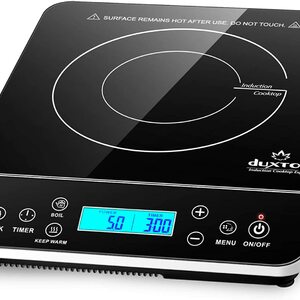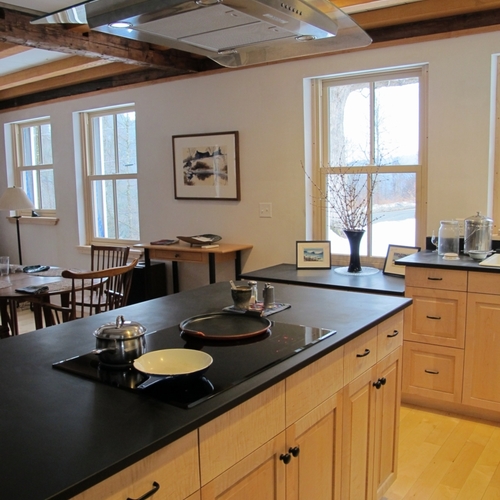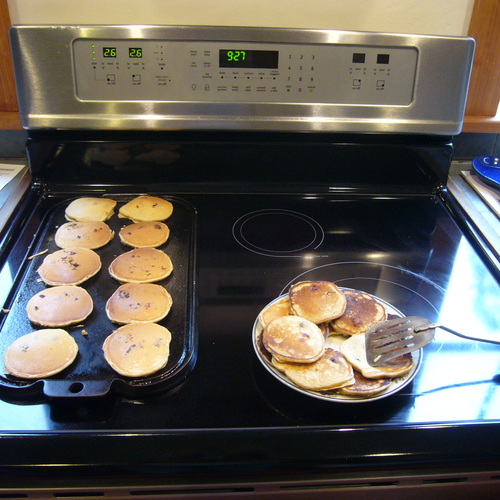Image Credit: Wikimedia Commons
Image Credit: Wikimedia Commons Michael Faraday was the Steve Jobs of the 19th century.
Image Credit: Wikimedia Commons
Last Friday was Pi Day, named for that special number, 3.14159265358979323846264338327950288…
The three dots at the end mean that I’ve exhausted my memory of the digits of pi, but pi doesn’t care. It just goes on and on. Anyway, Pi Day is a perfect day for a physics lesson because so many physics equations (and solutions) use that special number. And what better physics lesson for Pi Day than one about a device that cooks yummy things for us!
It seems like everywhere I go lately I hear about how if you want the best possible indoor air quality, you should use an induction cooktop. (Maybe if I stopped stalking Iain Walker, that wouldn’t happen so much.) Also, they’re about the most energy efficient way to cook. Alex Wilson, the green guru of Environmental Building News, just this week wrote an article about induction cooktops and why he chose one for his big renovation. He did a good job explaining the physics behind them, too, but I think I can add a bit to what he said… and even tie it in with some dancing, too!
Michael Faraday was the Steve Jobs of 19th century physics
Michael Faraday was born to a family that wasn’t well off. He pretty much taught himself everything he knew and got into the Royal Institution by impressing some folks, especially Sir Humphry Davy, with his smarts. Davy hired him as a secretary and promoted him to chemical assistant. But Faraday was not a gentleman, in the English sense, and had to serve as Davy’s valet on a tour of the continent.
In other words, Faraday did whatever he had to do to advance his ideas. And he had plenty of them. By the end of his career, he’d made more big discoveries in physics and chemistry than the great majority of scientists who have ever lived. He’s right up there with Newton and Einstein.
Every time you turn on a blender or a fan or your car, you can thank him for his law of electromagnetic induction, also known as Faraday’s Law. It’s so important that it’s one of the four equations that compose Maxwell’s Equations, which tell you pretty much everything you need to know about electromagnetism.
“She made me do it!”
Induction means something is being induced. You know, like when you’re a kid and you get in trouble for setting that field on fire, and you explain to your mom, “But she†made me do it.” Except that in the case of electromagnetic induction, she really did. “She,” here, would be a changing magnetic field.
Take a magnet, especially a strong one like those little neodymium magnets, and wave it near a piece of copper. You’ll induce a voltage in the copper. The voltage will get the electrons moving. Another neat thing about electric current is that it creates its own magnetic field. So a changing magnetic field can create an electric current, which creates another magnetic field.
Wouldn’t it be cool if the induced current created a magnetic field that opposed the original magnetic field. Magnets have north and south poles, right? If you put two north poles together or two south poles together, they repel each other. As it turns out, the induced magnetic field does oppose the original magnetic field. (That’s called Lenz’s Law, by the way.)
So, going back to the magnet and copper idea, if that copper happens to be in a tube shape, and the neodymium magnet drops down inside it, the current will create a magnetic field that puts north against north, south against south, and will act against gravity to slow down the magnet’s fall. Just like you see in this video:
Wow! Now that is cool! Lenz’s Law doesn’t really have much to do with induction cooktops, but hey, in honor of Pi Day, we’re just having fun with physics here. The fact that the changing magnetic field sets up those electric currents in the copper pipe is what’s important. An induction cooktop does the same thing. I just wouldn’t trust the opposing magnetic field to slow your pot down if it falls off the stove.
Here’s another cool video that gives you a bit more background on Faraday’s Law.
Let’s call them Faraday cooktops
Back to the original topic now: induction cooktops. Under the ceramic top that you put the pots and pans on are electromagnets, coils of copper wire that produce magnetic fields when electric current runs through them (see Image #2, below). The key to Faraday’s Law is a changing magnetic field, and an alternating current does that for us nicely. To ramp up the heating, the electronics you see under the cooktop also ramp up the frequency.
As the alternating current through that coil sets up the changing magnetic field, the pots and pans on the cooktop feel an induced voltage and the electrons start moving. When you put the right kind of metal pan on the stove, the kind with good magnetic properties, the pan responds with electric currents. The electrical resistance in the metal pan then turns that energy into heat.
The pan gets hot. The cooktop doesn’t, except by conduction from the pan downward. So all the electrical energy that goes into the cooktop turns into heat in the pan itself. You get minimal heat loss and high energy efficiency.
But wait! There’s more. Electromagnetic induction creates eddy currents in the metal pan, and the resistance turns the energy into heat, but that’s not the only process that creates heat. Induction cooktops work best with pots and pans made of ferromagnetic material, the stuff that permanent magnets are made of. When the electromagnet under the cooktop changes the magnetic field at high frequency, it flips the magnetic polarity of the material back and forth, too. All that pole-switching generates heat.
I haven’t been able to find the relative contributions of the eddy currents and magnetic pole-switching and I’m not an Enrico Fermi who can calculate it from first principles, so I’ll just leave it at that for now. Heat is generated in two ways. If you have more info, please let me know.
Another way to think of it is that this induction thing is kind of like when one person starts dancing and then others are moved to join in.
Allison Bailes of Decatur, Georgia, is a speaker, writer, energy consultant, RESNET-certified trainer, and the author of the Energy Vanguard Blog. You can follow him on Twitter at @EnergyVanguard.
Footnote
†I use the feminine here not to make you think that I’m a woman but rather to inject some balance in my use of pronouns. If I wanted to make you think I were a woman I’d just tell you that my name is Allison, which it is, and that I’m in Who’s Who of American Women – The Millennium Edition, which I am. Also, I used “she” to throw off you off and make you think it might have been my sister who made me do it when in fact it was my neighbor Bubba, who is not a woman. Well, he wasn’t a woman — or even a girl — back then anyway. I have no idea what twists and turns his life may have taken after that fateful day when the fire truck came to put out our fire.
Weekly Newsletter
Get building science and energy efficiency advice, plus special offers, in your inbox.
















5 Comments
A couple of thoughts
You can avoid the whole pronoun sink-hole by using the plural, as in " If a builder tries to fix an induction cooktop they won't get far". An approach endorsed by Dickens, Austen and Shakespeare among others.
I didn't know they allowed dancing in Georgia.
Happy pi day
Well done. I mean good job, not "make my steak well done." Although I do like my steak well done. Just saying.
I've installed them in 2 projects, both clients have been thrilled.
reliability and other concerns
Having had some supposedly top quality gas ranges with electronic components that have been expensive to keep operating, I am concerned with the long-term reliability of induction cook tops. What kind of repairs are going to be needed to keep them going for 15 to 20 years?
My wife, who cans a lot of our garden produce using some large (expensive) non-magnetic stainless steel stock pots and large aluminum pressure canners, is concerned about not being able to use these necessities on induction cook tops. Is there any good research on using an iron or steel disc under aluminum cookware? (No on makes stainless steel pressure canners, only small pressure cookers).
Reply to Jim
Your comment brings up a wider question as to whether the future of green building is going to be homes controlled and dependant on a large number of sophisticated electronic components, and what these are going to be connected to.
There are issues not only about reliability and cost, but also how these controls may disempower the owners who can not maintain them without professional help.
The connectivity of these devices within the home, especially through companies like Google whose business consists of aggregating our personal data for sale, and Nest the home appliance manufacturer they have merged with, brings up important privacy concerns.
I think all this needs addressing, rather than simply viewing all this innovation only through the lens of the energy efficiency gains these new technologies offer.
Thanks for a fun posting.
I enjoyed it, and learned a few things.
Log in or create an account to post a comment.
Sign up Log in